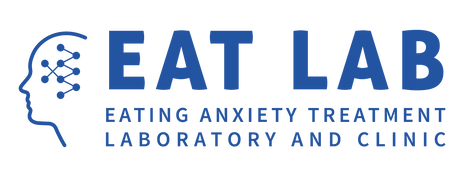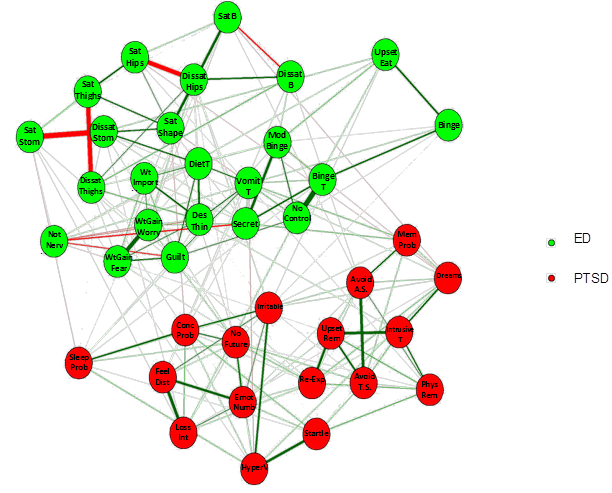|
Network Models of Psychopathology Part II by Benjamin Calebs, B.A. Clinical Implications of Network Analysis Network analysis can also help identify which symptoms might be most important to maintaining a mental disorder. If we can identify the most important symptoms of a disorder, then perhaps clinical interventions targeted at these symptoms could cause reductions in the severity of other symptoms in the network (Borsboom & Cramer, 2013; McNally, 2016). For example, if a client has symptoms of generalized anxiety disorder such as irritability, insomnia, and worry, network models suggest that it would be beneficial to target the core symptoms that are causally related to many others within the mental disorder. If clinicians were to target the symptom of excessive worry then this could reduce both the insomnia and the irritability arising from the insomnia. By targeting core symptoms in this manner, therapeutic interventions such as cognitive behavioral therapy could indirectly impact many other symptoms of a mental disorder. Comorbidity Network analysis also affords researchers a deeper understanding of comorbidity (two or more disorders occurring at the same time) between different mental disorders (Cramer, Waldorp, van der Maas, & Borsboom, 2010). Many mental disorders are highly comorbid with other mental disorders. When mental disorders are conceptualized as networks of symptoms, researchers can look at the interaction between specific symptoms across disorders that may be contributing to the comorbidity. For example, researchers could look at a comorbidity network containing symptoms of both post-traumatic stress disorder and eating disorders to see how the disorders interact (see figure below from some exciting new work in our lab!). Researchers could then look for core symptoms in a comorbidity network in the same way that one looks for such symptoms in a single disorder. Researchers can also look for symptoms that bridge the mental disorders to see how symptoms of one disorder might relate to the development of symptoms in other disorders (Borsboom & Cramer, 2013). If targeted clinical interventions are directed at the core symptoms or bridge symptoms in a comorbidity network then this could reduce symptoms across the different mental disorders.
Network models of psychopathology also have the benefit of allowing researchers to look at causal relationships between the different symptoms (Borsboom & Cramer, 2013; McNally, 2016). However, to actually determine causality one would need to gather longitudinal or experimental data. This is one of the exciting directions in which research on network models of psychopathology is headed. Researchers are beginning to develop ways of comparing networks across time to see how changes in the network structure of a mental disorder relate to changes in symptom severity (Beard et al., 2016; van Borkulo et al., 2015). As can be seen, network models of psychopathology have many benefits and open up exciting possibilities for both research and clinical practice.
0 Comments
Leave a Reply. |
Archives
January 2024
Categories |
- About
- People
- Our Research & Publications
-
Participate in Research
- Personalized Interventions and Outcomes: Navigating Eating Disorder Experiences and Recovery (PIONEER) Study (Online)
- Youth Eating Study (YES!)
- Tracking Restriction, Affect and Cognitions (TRAC) Study (Online)
- Virtual Reality Study
- Facing Eating Disorder Fears Study (Online)
- Personalized Treatment and CBT-E Study (Online)
- Body Project Summer Camp
- The Body Project
- Clinical Screener Study (Online)
- Clinic, Supervision, and Consultation
- Blog & In the Press
-
Archived Studies
- Predicting Recovery Study (Online)
- Online Single Session Resources
- Reconnecting to Internal Sensations and Experiences (RISE) Study
- Web-Based Mindfulness Study
- Personalized Treatment Study
- Online Imaginal Exposure Study
- In-Vivo Imaginal Exposure Study
- Daily Habits 3 Study
- Daily Mood Study
- COVID-19 Daily Impact Study
- Conquering fear foods study
- Louisville Pregnancy Study
- Approach and Avoidance in AN (AAA) Study
- Web-Based Mindfulness for AN & BN Study
- Barriers to Treatment Access (BTA) Study!
- Mindful Self-Compassion Study
- Network EMA Study
- Legacy of Hope Summit Report
- DONATE-CURE EATING DISORDERS!
- Directions
- Statistical Consultation
- About
- People
- Our Research & Publications
-
Participate in Research
- Personalized Interventions and Outcomes: Navigating Eating Disorder Experiences and Recovery (PIONEER) Study (Online)
- Youth Eating Study (YES!)
- Tracking Restriction, Affect and Cognitions (TRAC) Study (Online)
- Virtual Reality Study
- Facing Eating Disorder Fears Study (Online)
- Personalized Treatment and CBT-E Study (Online)
- Body Project Summer Camp
- The Body Project
- Clinical Screener Study (Online)
- Clinic, Supervision, and Consultation
- Blog & In the Press
-
Archived Studies
- Predicting Recovery Study (Online)
- Online Single Session Resources
- Reconnecting to Internal Sensations and Experiences (RISE) Study
- Web-Based Mindfulness Study
- Personalized Treatment Study
- Online Imaginal Exposure Study
- In-Vivo Imaginal Exposure Study
- Daily Habits 3 Study
- Daily Mood Study
- COVID-19 Daily Impact Study
- Conquering fear foods study
- Louisville Pregnancy Study
- Approach and Avoidance in AN (AAA) Study
- Web-Based Mindfulness for AN & BN Study
- Barriers to Treatment Access (BTA) Study!
- Mindful Self-Compassion Study
- Network EMA Study
- Legacy of Hope Summit Report
- DONATE-CURE EATING DISORDERS!
- Directions
- Statistical Consultation


 RSS Feed
RSS Feed
